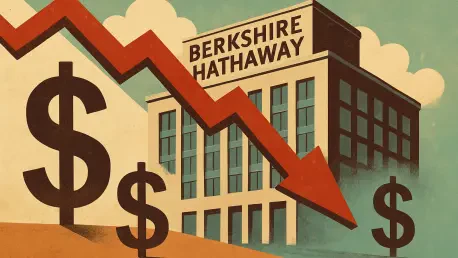Imagine a financial titan, long regarded as a beacon of stability in turbulent markets, reporting a staggering drop in net income due to investment setbacks, and you have Berkshire Hathaway’s latest quarterly results. Berkshire Hathaway, the conglomerate helmed by Warren Buffett, has faced just such a scenario, with net income plummeting to $12.37 billion from $30.35 billion a year ago. This sharp decline, driven by a $3.76 billion write-down on Kraft Heinz and reduced investment gains, has ignited discussions across the financial community. The purpose of this roundup is to gather diverse opinions, insights, and tips from industry analysts and market observers to dissect what this earnings report means for investors, the conglomerate’s strategy, and the broader economic landscape.
Unpacking the Financial Setback: Varied Perspectives on the Decline
Investment Losses Under the Microscope
Financial analysts have zeroed in on the massive write-down on Kraft Heinz as a critical factor behind Berkshire’s earnings drop. Many argue that this $3.76 billion impairment reflects not just a singular misstep but broader challenges in valuing consumer goods investments amid shifting market tastes. Some market watchers suggest that such write-downs are par for the course in a volatile environment, emphasizing that they do not necessarily indicate a flawed investment philosophy.
Others, however, express concern over the sharp fall in realized investment gains, which tumbled to $4.2 billion from $47.0 billion year-over-year for the quarter. A segment of industry commentators points out that this highlights a potential overexposure to specific underperforming assets. They caution that without a strategic reassessment, similar losses could recur, impacting shareholder confidence over time.
Contrasting views emerge on whether this signals deeper portfolio issues or merely temporary fluctuations. While one group of analysts sees this as a cyclical downturn that Berkshire’s diversified holdings can weather, another warns that persistent market volatility could challenge even the most robust investment frameworks. This divide underscores the uncertainty surrounding the conglomerate’s next moves.
Operating Earnings: A Silver Lining or False Comfort?
On the operational front, opinions are more aligned, with many experts noting the relative stability of Berkshire’s operating earnings at $11.16 billion, down only slightly from $11.60 billion last year. Several industry voices highlight this as evidence of strength in core business activities, suggesting that the conglomerate’s diverse operations provide a buffer against investment-related shocks. They argue that this resilience is a key metric for long-term investors to focus on.
Yet, some market observers caution against over-reliance on operational performance as a safety net. They point out that while units like manufacturing and railroads remain steady, the broader economic environment could still exert pressure if investment returns continue to falter. This perspective urges a balanced assessment of both operational and investment health when evaluating the company’s outlook.
A third angle comes from financial strategists who emphasize the importance of context. They note that operating earnings, while stable, cannot fully offset the psychological impact of headline net income drops on market sentiment. Their advice to investors is to dig deeper into segment-specific data rather than taking surface-level stability at face value, ensuring a comprehensive understanding of risks.
Segment-Specific Insights: Insurance and Beyond
Insurance Operations: Mixed Signals Draw Scrutiny
Berkshire’s insurance segment, often seen as a cornerstone of its business model, has elicited a range of reactions due to its mixed performance. GEICO’s robust pre-tax earnings of $1.82 billion have been widely praised by industry analysts as a sign of effective management and market positioning. Many see this as proof that certain insurance units can thrive despite broader industry headwinds like rising claims costs.
However, the weaker results in primary insurance and reinsurance groups, with pre-tax earnings dropping to $63 million and $650 million respectively, have raised eyebrows. Some commentators attribute these declines to competitive pricing pressures and regional challenges, suggesting that not all insurance operations are equally equipped to handle current market dynamics. They argue for targeted improvements in underperforming areas.
A differing opinion focuses on the insurance float, which grew to $174 billion, as a potential game-changer. Certain financial experts believe this increase signals untapped investment potential, even as underwriting results vary. Their take is that while immediate earnings may be inconsistent across segments, the long-term capacity to leverage float for returns could offset current disparities if managed strategically.
Market Volatility: How Much Blame Lies Externally?
The role of broader market dynamics in Berkshire’s investment losses has sparked heated debate among financial circles. Many analysts agree that external volatility, coupled with specific impairments like Kraft Heinz, has disproportionately hit the conglomerate’s bottom line. They argue that even diversified portfolios are not immune to sudden shifts in consumer sectors or macroeconomic trends, pointing to this as a systemic rather than company-specific issue.
A contrasting viewpoint suggests that while market conditions play a role, Berkshire’s exposure to certain assets reflects a need for tighter risk management. Some industry observers contend that the conglomerate’s traditional buy-and-hold strategy may require recalibration to better navigate rapid market changes. They propose that a more dynamic approach to portfolio adjustments could mitigate future losses.
Another perspective emphasizes learning from historical patterns, noting that Berkshire has faced similar unrealized losses in prior quarters. A group of market strategists advises that while current challenges are significant, they also offer unique insights into managing risk within a conglomerate model. Their tip for investors is to monitor how Berkshire adapts its investment decisions in response to these external pressures over the next few quarters.
Key Takeaways and Investor Tips from the Community
Analysts and market watchers collectively underscore the dual narrative of operational resilience versus investment vulnerability as the defining theme of Berkshire’s recent performance. A common tip for investors is to prioritize operating earnings over net income when assessing the company’s fundamental health, as this metric offers a clearer picture of ongoing business strength amid market-driven noise.
Another widely shared insight is the need to closely track market trends affecting key holdings like Kraft Heinz. Financial advisors suggest that understanding sector-specific risks can help investors anticipate potential write-downs or gains in Berkshire’s portfolio. They recommend staying informed on consumer goods and other volatile industries as a proactive measure.
Lastly, diversification emerges as a recurring piece of advice for stakeholders. Many experts encourage mirroring Berkshire’s broad business spread in personal portfolios to cushion against similar investment shocks. Their guidance is to balance high-risk assets with stable, income-generating ones, ensuring that a single market downturn does not disproportionately impact overall returns.
Final Reflections and Next Steps
Looking back, the discourse surrounding Berkshire Hathaway’s Q2 earnings painted a complex picture of a financial giant grappling with significant investment setbacks while leaning on operational stability. Analysts and industry observers provided a wealth of perspectives, from concerns over portfolio vulnerabilities to optimism about insurance float and core business strength, offering a multifaceted view of the challenges faced.
For those navigating the aftermath, a practical next step is to delve deeper into segment-specific performance, particularly in insurance, to identify areas of potential growth or concern. Investors are encouraged to reassess their own risk exposure in light of market volatility lessons drawn from Berkshire’s experience, seeking diversified strategies as a safeguard.
Beyond individual action, the broader financial community is urged to keep a close watch on how conglomerates like Berkshire adapt to an evolving economic landscape. Exploring further resources on investment risk management and sector trends emerges as a valuable path forward, ensuring that the insights gained from this earnings period inform smarter decision-making in the quarters ahead.









